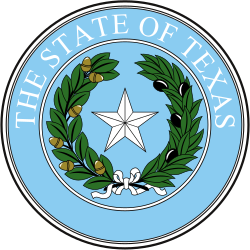Oath of Office and Election
Governors of Texas are directly elected by registered voters in Texas and serve terms of four years, with no term limits. Before executing the powers of the office, a governor is required to recite the oath of office as found in Article XVI, Section 1 of the Constitution of Texas:
I, _______________________, do solemnly swear (or affirm), that I will faithfully execute the duties of the office of governor of the State of Texas, and will to the best of my ability preserve, protect, and defend the Constitution and laws of the United States and of this State, so help me God. [3]
Incoming Texas governors take office on the third Tuesday of January following an election.
Historical development
The state's first constitution in 1845 [5] established the office of governor, to serve for two years, but no more than four years out of every six (essentially a limit of no more than two consecutive terms). [6] The 1861 secessionist [7] constitution set the term start date at the first Monday in the November following the election. [8] The 1866 constitution, [9] adopted just after the American Civil War, increased terms to 4 years, but no more than 8 years out of every 12, and moved the start date to the first Thursday after the organization of the legislature, or "as soon thereafter as practicable". [10] The Reconstruction-era constitution of 1869 removed the limit on terms, [11] Texas remains one of 16 states, territory or jurisdiction (including the U.S. Territory of Puerto Rico and the District of Columbia) [12] with no gubernatorial term limits. The present constitution of 1876 shortened terms back to two years, [13] but a 1972 amendment increased it to four years again. [14]
The gubernatorial election is held every four years on the Tuesday after the first Monday in November that does not coincide with the presidential elections. All gubernatorial elections have been a part of the midterm elections since the 1974 election, invalidating the latter. The governor is sworn in every four years along with the lieutenant governor.
Despite the lack of term limits, no Texas governor in the 19th or 20th century ever served more than seven and a half consecutive years in office (Allan Shivers) or eight years total service (Bill Clements, in two non-consecutive four-year terms). Former governor Rick Perry, who served from 2000 to 2015, surpassed both these records, becoming the first Texas governor to serve three consecutive four-year terms. When Perry won the general election on November 2, 2010, he joined Shivers, Price Daniel, and John Connally as the only Texas governors elected to three terms (the terms served by governors Shivers, Daniel, and Connally were two-year terms). On November 8, 2022, current governor Greg Abbott was re-elected and became the fifth Texas governor to serve three terms following Shivers, Daniel, Connally and Perry. In case of a vacancy in the office of governor, the lieutenant governor becomes governor. [15] This rule was added only in a 1999 [16] amendment, prior to which the lieutenant governor only acted as governor, except during the time of the 1861 constitution, which said that the lieutenant governor would be styled "Governor of the State of Texas" in case of vacancy. [17]
The Lieutenant Governor of Texas has influence over state policy because of their control of the Texas Senate's agenda and committee assignments. This influence is close to that of the governor's in things like legislative matters like budgeting and election law.
Executive powers
Texas utilizes a plural executive government where no single government official is solely responsible for the Executive Branch. [18] The Texas governor has a very minimal control over the Legislative Budget Board. The Lieutenant Governor and Speaker of the House manages the state's budget. [19]
Plural Executive System
Texas is unique because of how it has a plural executive system where executive officials like the lieutenant governor, attorney general, comptroller, land commissioner, and the agriculture commissioner are elected independently. This causes the governor's direct control over executive policies to be extremely limited versus other states that have centralized executive authority. (Rottinghaus, 2024). [2]
This page is based on this
Wikipedia article Text is available under the
CC BY-SA 4.0 license; additional terms may apply.
Images, videos and audio are available under their respective licenses.






